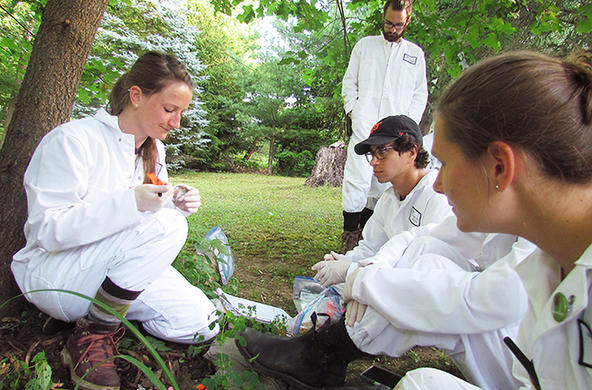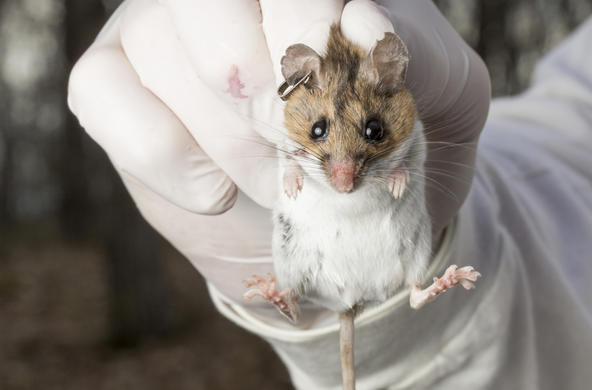Mild winters and big deer and mice populations mean more ticks and higher rates of Lyme disease diagnoses
Milder winters, burgeoning mice and deer populations and a bumper acorn crop from two years ago mean this year's tick season is expected to be bad and more widespread, experts say. With that comes the threat of more tick-borne diseases, including the most common, Lyme disease.
States like Connecticut—home to the town of Old Lyme where the disease was first diagnosed—are already reporting a higher number of ticks infected with the Borrelia burgdorferi bacterium, which causes Lyme disease, as well as other tick-borne pathogens. The deer or blacklegged tick can transmit up to seven pathogens that cause human diseases, including Lyme disease.
The state collects ticks from residents, and of the more than 800 received thus far this year, nearly 38% have tested positive for Lyme disease, compared with an average of about 27% in the past five years for the full season, said Goudarz Molaei, a research scientist at the Center for Vector Biology and Zoonotic Diseases, part of the Connecticut Agricultural Experiment Station, a state-owned research facility.
Lyme disease is the most common vector-borne disease in the U.S.
Symptoms can include a ring-like rash, along with flulike symptoms, muscle and joint aches and swollen lymph nodes. It is usually diagnosed based on symptoms or a blood test. It is treated with antibiotics. Longer-term infections can cause more serious symptoms, including arthritis, severe muscle pain and headaches, heart palpitations, brain inflammation and nerve pain. Diagnosis and treatment of Lyme disease is controversial with many differences of opinion between patient groups and doctors.
About 10% of ticks have tested positive for the pathogen that causes Babesiosis, a malaria-like disease, and 5% have tested positive for the bacteria that causes Anaplasmosis, a flulike disease that can be fatal if left untreated. Due to the ticks’ tiny size, they can be difficult to see.

“This problem is going to stay with us and it is going to get worse,” said Dr. Molaei. Milder winters and no snow cover or frost means more ticks survive, he said.
The harbinger of how bad a tick season is going to be is the acorn supply, said Richard S. Ostfeld, a senior scientist at the Cary Institute of Ecosystem Studies in Millbrook, N.Y., who has been monitoring local tick populations and their hosts for 25 years.
In 2015 there was a bumper acorn crop, he said, which led to an explosion of white-footed mice last summer. That meant more hosts for baby ticks to latch onto. The mice are what infect some ticks with Lyme and other diseases.
“Ticks survive really well when they feed on a mouse compared to other animal hosts so more ticks survive to the nymph stage,” said Dr. Ostfeld. “So our expectation is that we should have an unusually large number of infected nymph-stage ticks starting next month.”
Ticks have a two-year life cycle and feed from hosts three times during that period. Most cases of Lyme disease in people are transmitted by nymph-stage ticks. The adult ticks also feed on deer so deer populations help adult ticks reproduce, although the deer don’t infect the ticks and when they bite humans they are bigger and easier to detect and remove.
The Centers for Disease Control and Prevention estimates there are more than 300,000 new cases of Lyme disease a year, about triple the rate from two decades ago. Most cases are centered in the Northeast, mid-Atlantic region and Upper Midwest states, such as Minnesota and Wisconsin. On the West Coast, where it is less common, it is spread by a different species, the western blacklegged tick.
Getting bit by a deer tick doesn’t mean you will get Lyme disease. On average 10 to 30% of deer nymphal ticks are infected with Lyme disease, depending on the region, said Rebecca Eisen, a research biologist with CDC’s Division of Vector-borne Diseases.
Ticks typically feed on humans for three to five days, said Jorge Parada, a medical director of infection prevention and control at Loyola University Medical Center in Maywood, Illinois. A tick that latches on for only a few hours is unlikely to transmit infection. For Lyme disease to be transmitted, a tick usually has to be attached for 24 to 48 hours, said Dr. Parada, though for some other diseases it is less time. Thus, “the importance of doing tick checks.”
Ticks won’t crawl a lot once on a host, said Dr. Parada. They are usually found on the lower extremities, as they cling on to legs when people are walking through wooded areas or grass. Sometimes they will drop down onto people from a higher bush and end up in someone’s hair or behind the ear.
Once done with a feeding, the tick will fall off on its own, said Dr. Parada. Many Lyme disease patients never see a tick on them, which can make diagnosis of the disease difficult.
Valneva, a biotech company based in France, recently started a phase one clinical trial for a Lyme disease vaccine in humans in both Europe and the U.S.
The trial includes 180 subjects and is focusing on the safety of the vaccine.
Unfortunately, approval is far away. A spokeswoman for the company said the first approval could happen at the end of 2024 at the earliest.
How to avoid ticks and prevent Lyme disease
Avoid tall grass, leaf piles and wooded areas. Stay in the center of walking and hiking trail
-Use repellent that contains DEET — 20% or more — on skin and clothing.
-If camping or hiking, treat clothing and gear with permethrin
-When working outside or walking in the woods, wear long sleeves and long pants and stick your pants inside your socks. Wear lighter colored clothing so you can see ticks more easily.
-Do a thorough tick check of the body using a mirror. Make sure to check hard-to-reach areas, including under the arms, behind the ears, inside the belly button, behind the knees and in the groin area. A lice comb can help for checking hair.
-Showering or bathing after spending time outside can wash off ticks that haven’t latched on yet.
-Check pets and clothing and equipment that has been outside for crawling ticks.
-Drying clothes on high heat for 10 minutes can kill ticks. Add additional drying time for wet clothes.
-Regularly mow or trim your lawn to avoid tall grass and rake leaves.
-Place a 3-foot wide barrier of gravel or wood chips between the lawn and wooded areas. Try to maintain a 9-foot barrier between the wood chips and areas such as the patio, garden and play areas.
-Try to plant crops that deer don’t like or erect an 8-foot fence to keep them out.
-Spray your yard with acaricides or tick pesticides to help reduce the number of ticks.
Sources: CDC; Connecticut Agricultural Experiment Station; Patricia DeLaMora, Weill Cornell Medicine, Manhattan, New York; Jorge Parada, Loyola University Medical Center, Maywood, Illinois.







